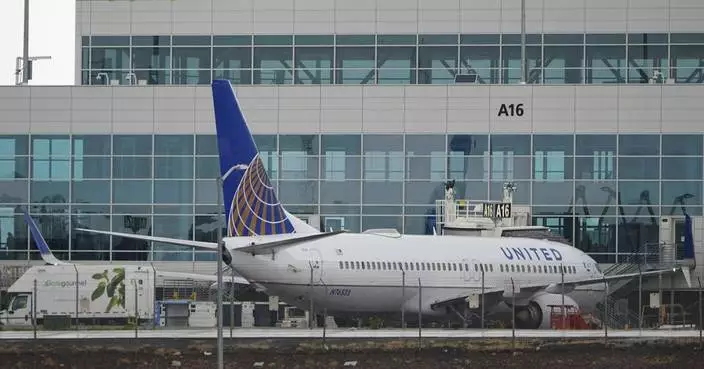Ever since Willie Nelson left Nashville in the early 1970s to return to Texas, there's been a large chasm between the "red dirt" country artists working primarily in Texas and Oklahoma and the polished, radio friendly music being produced in Nashville.
Even today, there's a separate country radio chart for Texas stations and the independent country acts that are popular there often get labeled in Nashville as just "regional artists."
East Texas-raised Cody Johnson spent more than a decade in that musical scene and heard the distrust that many Texas country artists had for Nashville record labels.

FILe - This April 7, 2019 file photo shows Cody Johnson at the 54th annual Academy of Country Music Awards in Las Vegas. The Texas-born singer knew there was a lot of distrust of Nashville major record labels among his peers in Texas and Oklahoma. But after a decade as a successful indie artist, Johnson finally signed to Warner Music Nashville and he’s hoping to bridge that cultural divide by straddling the traditional and the modern. (Photo by Jordan StraussInvisionAP, File)
"There were a lot of artists from that era who were probably a bit arrogant in the fact that 'I'm from Texas and I've got this and you're not going to tell me what to do,'" Johnson said. "I think there has been something lost on some guys from Texas that maybe thought they were Willie or Waylon."
Johnson, a former rodeo cowboy turned country singer, wants to bridge that gap by straddling the traditional and the modern, Texas and Nashville, and he's finding an audience his own way.
Warner Music Nashville's executive vice president for A&R Cris Lacy tried to sign Johnson for years, but he kept rejecting their offers. Lacy knew that major labels often got stereotyped as being heavy handed with new artists by changing their sound or forcing they work with certain producers. But she was also trying to overcome a cultural challenge.
"There's so much pride in the Texas music scene because it is so special," Lacy said. "They are very protective of it. And each Texas artist has to think about when they move on to the next step, are they going to alienate the people that believed in them?"
As an independent artist, Johnson released two albums that reached the top 10 without major label support or distribution and sold out the Houston Rodeo with 74,000 tickets. But Johnson knew that he couldn't make the next leap without the support of a label and commercial country radio.
Last year, Johnson a signed a deal with Warner Music Nashville in a 50-50 partnership with his own imprint called CoJo Music. He made it clear that he wanted creative control, including choosing his own producer and songs, owning his own publishing and even deciding how he dressed.
"There were a lot of people that wanted to change a lot about me. This being a huge factor for a lot of people," he said, pointing to his cowboy hat.
His debut as a Warner artist, "Ain't Nothin' To It," hit the top of Billboard's country album chart in January, and his first single from that album, "On My Way To You," peaked at No. 11 on Billboard's Country Airplay Chart, his best charting single yet. He's opening up for George Strait and Blake Shelton at Gillette Stadium in Foxborough, Massachusetts, in August. He also opened for Luke Combs, one of country radio's fastest rising stars, on select dates this summer.
Johnson's album reflects the traditional country he idolizes but adds elements of gospel, rock and blues to sound fresh for younger ears. He chose a honky-tonk blues song written by Chris Stapleton, a rocking Charlie Daniels cover, a couple songs about the rodeo, a gospel song and a cover of Roger Miller's "Husbands and Wives."
But Johnson doesn't hold back his opinion of what he considers a bandwagon approach to contemporary country music — replicating over and over what's popular but lacks real creativity.
"It robs your listeners of authenticity," Johnson said. "I don't want to be bubblegum, and I don't care if there's a $50 million signing bonus to be bubblegum. It's not worth it to me."
He knows that he's not going to change the trend of country music back to the traditional sound he grew up listening to, but he's proving there's still a market for that music.
"I think that Warner is breaking new ground and they are giving power to artists who do know who they are," Johnson said.
Online:
www.codyjohnsonmusic.com
Follow Kristin M. Hall at http://twitter.com/kmhall
New Jersey Transit train engineers went on strike Friday, leaving an estimated 350,000 commuters in New Jersey and New York City to seek other means to reach their destinations or consider staying home.
The walkout comes after the latest round of negotiations on Thursday didn’t produce an agreement. It is the state’s first transit strike in more than 40 years and comes a month after union members overwhelmingly rejected a labor agreement with management.
“We presented them the last proposal; they rejected it and walked away with two hours left on the clock," said Tom Haas, general chairman of the Brotherhood of Locomotive Engineers and Trainmen.
NJ Transit CEO Kris Kolluri described the situation as a “pause in the conversations.”
“I certainly expect to pick back up these conversations as soon as possible,” he said late Thursday during a joint news conference with New Jersey Gov. Phil Murphy. “If they’re willing to meet tonight, I’ll meet them again tonight. If they want to meet tomorrow morning, I’ll do it again. Because I think this is an imminently workable problem. The question is, do they have the willingness to come to a solution.”
Murphy said it was important to “reach a final deal that is both fair to employees and at the same time affordable to New Jersey’s commuters and taxpayers.”
"Again, we cannot ignore the agency’s fiscal realities,” Murphy said.
The announcement came after 15 hours of non-stop contract talks, according to the union. Picket lines are expected to start at 4 a.m. Friday.
NJ Transit — the nation’s third-largest transit system — operates buses and rail in the state, providing nearly 1 million weekday trips, including into New York City. The walkout halts all NJ Transit commuter trains, which provide heavily used public transit routes between New York City’s Penn Station on one side of the Hudson River and communities in northern New Jersey on the other, as well as the Newark airport, which has grappled with unrelated delays of its own recently.
The agency had announced contingency plans in recent days, saying it planned to increase bus service, but warned riders that the buses would only add “very limited” capacity to existing New York commuter bus routes in close proximity to rail stations and would not start running until Monday. The agency also will contract with private carriers to operate bus service from key regional park-and-ride locations during weekday peak periods.
However, the agency noted that the buses would not be able to handle close to the same number of passengers — only about 20% of current rail customers — so it urged people who could work from home to do so if there was a strike.
Even the threat of it had already caused travel disruptions. Amid the uncertainty, the transit agency canceled train and bus service for Shakira concerts Thursday and Friday at MetLife Stadium in New Jersey.
The parties met Monday with a federal mediation board in Washington to discuss the matter, and a mediator was present during Thursday’s talks. Kolluri said Thursday night that the mediation board has suggested a Sunday morning meeting to resume talks.
Wages have been the main sticking point of the negotiations between the agency and the Brotherhood of Locomotive Engineers and Trainmen that wants to see its members earn wages comparable to other passenger railroads in the area. The union says its members earn an average salary of $113,000 a year and says an agreement could be reached if agency CEO Kris Kolluri agrees to an average yearly salary of $170,000.
NJ Transit leadership, though, disputes the union’s data, saying the engineers have average total earnings of $135,000 annually, with the highest earners exceeding $200,000.
Kolluri and Murphy said Thursday night that the problem isn’t so much whether both sides can agree to a wage increase, but whether they can do so under terms that wouldn’t then trigger other unions to demand similar increases and create a financially unfeasible situation for NJ Transit.
Congress has the power to intervene and block the strike and force the union to accept a deal, but lawmakers have not shown a willingness to do that this time like they did in 2022 to prevent a national freight railroad strike.
The union has seen steady attrition in its ranks at NJ Transit as more of its members leave to take better-paying jobs at other railroads. The number of NJ Transit engineers has shrunk from 500 several months ago to about 450 today.
Associated Press reporters Hallie Golden in Seattle and Josh Funk in Omaha, Nebraska, contributed to this report.

An electronic display advises commuters of NJ Transit service disruptions at the Secaucus Junction station in Secaucus, N.J., Wednesday, May 14, 2025. (AP Photo/Seth Wenig)

An electronic display advises commuters of potential NJ Transit service disruptions at the Secaucus Junction station in Secaucus, N.J., Wednesday, May 14, 2025. (AP Photo/Seth Wenig)

An electronic display advises commuters of NJ Transit service disruptions at the Secaucus Junction station in Secaucus, N.J., Wednesday, May 14, 2025. (AP Photo/Seth Wenig)

An NJ Transit train pulls into the Secaucus Junction station in Secaucus, N.J., Wednesday, May 14, 2025. (AP Photo/Seth Wenig)

An electronic display advises commuters of potential NJ Transit service disruptions at the Secaucus Junction station in Secaucus, N.J., Wednesday, May 14, 2025. (AP Photo/Seth Wenig)


























































